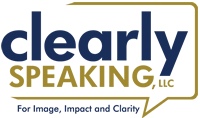
10 Dynamic Ways to Open Your Presentation That Will Rivet Your Audiences
If you are giving a speech in the near future, I’d like to challenge you to try something new… Your task is to pick a topic that you love to talk about and create 10 different possible openings for your presentation on that topic. Your dynamic opening is going to help your listeners decide if they want to listen to you and they will decide in 30 seconds or less. Making a strong positive and interesting opening will help you make a great first impression and help them to decide if you are credible.
Here is an example of what I’d like you to try. I frequently talk about executive speech and voice branding because I want to create an awareness about how you can control the way you sound to your desired perception. Here are 10 different ways to start my presentation using 10 different styles:
1. State or show the importance.
“If you are one of 75.4 million millennials aspiring to climb the corporate ladder, you’ve got competition! The way you sound matters and will significantly contribute to your success at reaching your goals. Rebecca, a client of mine, had been identified as a promising, young executive. But people complained about the way she sounded so she was bypassed when it came to being the company spokesperson, giving presentations or facilitating discussions.”
2. Make a startling statement
“Did you know that job interviewers will decide within seconds (about 7 seconds) whether they WON’T hire you. That sentence took me about 10 seconds to say, and if you are a job interviewer, you’ve probably decided something about me.”
3. Arouse suspense and curiosity with a question.
“Have you ever imagined what it would be like to be in front of a large audience and everyone was paying attention to you and hanging on every single word that you said? What if I told you that is completely possible!”
4. Tell a story or anecdote
When I was a young speech language pathologist first entering the workforce, my employer sent me to a workshop on branding. Although I didn’t have any idea was that meant, I learned very quickly and discovered that I wasn’t projecting the sound or look of a credible professional or an expert in my field.”
5. Ask a rhetorical question.
“What would it mean to you if you woke in the morning and didn’t have a voice? ”
6. Begin with a quote, statistic or challenge
Statistic: “Effective communication is about 20% of what you know and 80% of how you feel about what you know.”
Quote: Brian Tracy said, “Communication is a skill that you can learn. It’s like riding a bicycle or typing. If you’re willing to work at it, you can rapidly improve the quality of every part of your life.” I couldn’t agree more!
Challenge: For the next hour, I challenge you to think differently about the way you sound and the effect you want to have on other people.
7. Humor—I have a put up a pictures of animals in funny positions and related the picture to the topic. I have used one to help people understand that our perceptions might be different than someone else. You can also tell a joke that is self-deprecating.
8. Audience participation (ask them to raise their hand to answer)
“How many of you have ever heard yourself on a recording and liked what you heard? I have asked this question to every audience I speak to and I have never/rarely had anyone raise their hand! So, I want you to know that you are not alone! Would you like to do something about it?”
9. Demonstration/analogy:
The shape of your vocal tract and your vocal cords is what causes you to sound the way that you do. Much like any resonating instrument, the sound waves that you create at the level of your vocal cords bounce off the structures of your bones, tongue, etc.
10. Refer to a historical event
When Martin Luther King gave his speech, “I have a dream” in 1963, he effectively used the 12 elements of speech, language and voice to create a sound that was passionate, effective and excited his listeners. You, too can have an effect on your listeners whenever you choose to.
As you can see, there are many different ways to address your audience. Which one appeals to you? I might choose one over the other depending on who is in the audience. Some of them felt really powerful and others felt a bit flat to me. But, I could always “tweak” any of them to make them better. My point is that you, too, can do this exercise and create a number of opening that appeal to any crowd and then select the one that you think will be the most powerful.
Give it a try and let me know what you come up with.
Would you like to improve the way that you sound? Learn about our free Step-by-Step Voice Makeover webinar.
Tags: clearlyspeaking, opening presentations, speak with influence
